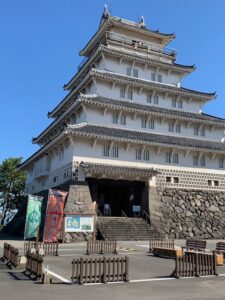The small town of Shimabara has an unmanned station, yet the town boasts two major attractions. One is a castle, and the other a samurai district. In its heyday the district boasted 690 homes grouped together to house foot soldiers. The area was known as Teppo-machi (Gun District) since the guards were armed with rifles as well as swords. (The first gun had arrived with Portuguese merchants in 1543, following which Japanese smiths were able to copy it and produce their own.)
The samurai houses are set either side of a small stream, and three were open to the public. The multipurpose tatami rooms looked almost identical, save for the tokonoma alcove displaying seasonal items. The minimalism and harmony with nature were in keeping with the Zen the warriors practised, and in keeping with Shinto values too. When the sliding walls that divide house and garden were removed, a unified space was created merging interior with the outdoors.
One of the residences served as a museum, focussed on the samurai heritage. The fee was just ¥300, but nonetheless the 80 year old running the museum insisted I have a discount for being English. The collection had an engagingly ad hoc feel, despite the vaguely chronological theme. The deeper you penetrated, the further it strayed from samurai matters, until finally there were simply beer cans and a gramophone from the 1950s.
As we walked round the exhibits, the old lady told me snippets about her life. Her father had died in the war, her daughter had married an Englishman, and when she visited London people had been kind to her, even though she did not speak the language.
‘Did you see the stream that flows between the houses?’ she asked. ‘It was the gift of Lord Matsudaira. Can you guess why?’
‘For their daily life,’ I suggested. ‘They needed water to live.’
‘Yes, but he wanted them to be thankful,’ she said. ‘So he provided fresh spring water. It was a gift of life, as if he was a god.’
Gratitude for the blessings of life run deep in Japanese culture, and it is a key element of Shinto also. Gratitude to one’s ancestors; gratitude for fresh water; gratitude to whoever was involved in providing food. “Gratefulness – the full response to a given moment and all it contains – is a universal practice that fosters personal transformation, cross-cultural understanding, interfaith dialogue, intergenerational respect, nonviolent conflict resolution, and ecological sustainability.” (For more about the benefits of gratitude, click here.)




Leave a Reply